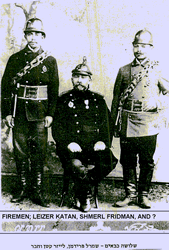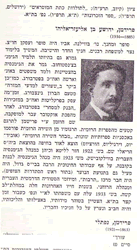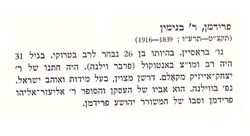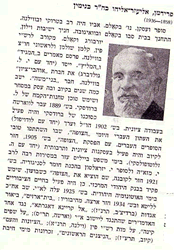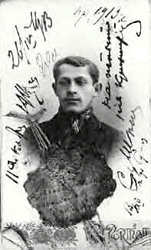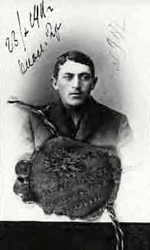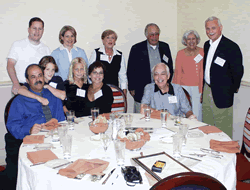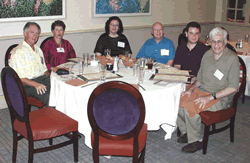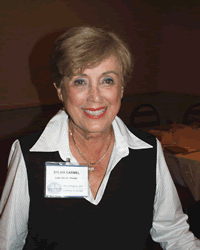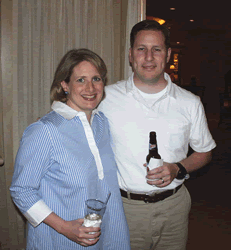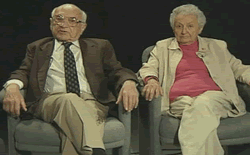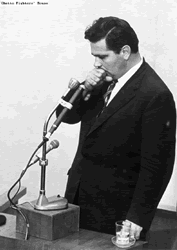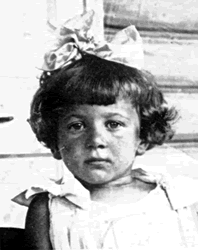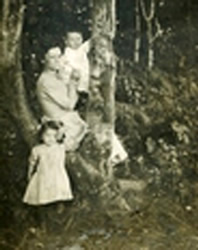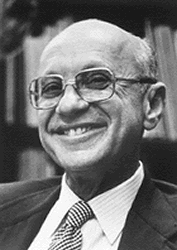
#fdm-7:
Milton Friedman
Autobiography
1930 census;
Sarah Friedman Age; 48 BirthYear;1881 Magyarorszag Head, widow, White
Rahway, Union, NJ Owned her home ($14,000) owned a Radio, Hebrew came
to the country in 1895 from Hungary
Tillie F Friedman Age;21 BirthYear; 1908 Â New York, Daughter
Rahway, Union, NJ
Helen Friedman Age;20 BirthYear: 1909 Â New York, Daughter
 Rahway, Union, NJ bookkeeper (for some Union)
Ruth Friedman Age;19 BirthYear; 1910 Â New York, Daughter
 Rahway, Union, NJ book keeper ( cork factory)
Milton Friedman Age;17 BirthYear; 1912 Â New York, Son Â
Rahway, Union, NJ
1920 census;
Friedman, Saul 41 BirthYear;1878 SLK White Main Street, Rahway, Union,
New Jersey , Hebrew, came to the country in 1893 from Udga? Hungary.
Merchant (wife; Sara, age 38 came from Beredger? Hungary- daughter:
Tillie, age 11,- daughter: Helen age 10,- daughter Ruth age 9- son Milton
age 7.)
I was born July 31, 1912, in Brooklyn, N.Y., the fourth and last child
and first son of Sarah Ethel (Landau) and Jeno Saul Friedman. My parents
were born in Carpatho-Ruthenia (then a province of Austria-Hungary;
later, part of inter-war Czechoslovakia, and, currently/1980, of the
Soviet Union). They emigrated to the U.S. in their teens, meeting in
New York. When I was a year old, my parents moved to Rahway, N.J., a
small town about 20 miles from New York City. There, my mother ran a
small retail "dry goods" store, while my father engaged in
a succession of mostly unsuccessful "jobbing" ventures. The
family income was small and highly uncertain; financial crisis was a
constant companion. Yet there was always enough to eat, and the family
atmosphere was warm and supportive.
Along with my sisters, I attended public elementary and secondary schools,
graduating from Rahway High School in 1928, just before my 16th birthday.
My father died during my senior year in high school, leaving my mother
plus two older sisters to support the family. Nonetheless, it was taken
for granted that I would attend college, though, also, that I would
have to finance myself.
I was awarded a competitive scholarship to Rutgers University (then
a relatively small and predominantly private university receiving limited
financial assistance from the State of New Jersey, mostly in the form
of such scholarship awards). I was graduated from Rutgers in 1932, financing
the rest of my college expenses by the usual mixture of waiting on tables,
clerking in a retail store, occasional entrepreneurial ventures, and
summer earnings. Initially, I specialized in mathematics, intending
to become an actuary, and went so far as to take actuarial examinations,
passing several but also failing several. Shortly, however, I became
interested in economics, and eventually ended with the equivalent of
a major in both fields.
In economics, I had the good fortune to be exposed to two remarkable
men: Arthur F. Burns, then teaching at Rutgers while completing his
doctoral dissertation for Columbia; and Homer Jones, teaching between
spells of graduate work at the University of Chicago. Arthur Burns shaped
my understanding of economic research, introduced me to the highest
scientific standards, and became a guiding influence on my subsequent
career. Homer Jones introduced me to rigorous economic theory, made
economics exciting and relevant, and encouraged me to go on to graduate
work. On his recommendation, the Chicago Economics Department offered
me a tuition scholarship. As it happened, I was also offered a scholarship
by Brown University in Applied Mathematics, but, by that time, I had
definitely transferred my primary allegiance to economics. Arthur Burns
and Homer Jones remain today among my closest and most valued friends.
Though 1932-33, my first year at Chicago, was, financially, my most
difficult year; intellectually, it opened new worlds. Jacob Viner, Frank
Knight, Henry Schultz, Lloyd Mints, Henry Simons and, equally important,
a brilliant group of graduate students from all over the world exposed
me to a cosmopolitan and vibrant intellectual atmosphere of a kind that
I had never dreamed existed. I have never recovered.
Personally, the most important event of that year was meeting a shy,
withdrawn, lovely, and extremely bright fellow economics student, Rose
Director. We were married six years later, when our depression fears
of where our livelihood would come from had been dissipated, and, in
the words of the fairy tale, have lived happily ever after. Rose has
been an active partner in all my professional work since that time.
Thanks to Henry Schultz's friendship with Harold Hotelling, I was offered
an attractive fellowship at Columbia for the next year. The year at
Columbia widened my horizons still further. Harold Hotelling did for
mathematical statistics what Jacob Viner had done for economic theory:
revealed it to be an integrated logical whole, not a set of cook-book
recipes. He also introduced me to rigorous mathematical economics. Wesley
C. Mitchell, John M. Clark and others exposed me to an institutional
and empirical approach and a view of economic theory that differed sharply
from the Chicago view. Here, too, an exceptional group of fellow students
were the most effective teachers.
After the year at Columbia, I returned to Chicago, spending a year as
research assistant to Henry Schultz who was then completing his classic,
The Theory and Measurement of Demand. Equally important, I formed a
lifelong friendship with two fellow students, George J. Stigler and
W. Allen Wallis.
Allen went first to New Deal Washington. Largely through his efforts,
I followed in the summer of 1935, working at the National Resources
Committee on the design of a large consumer budget study then under
way. This was one of the two principal components of my later Theory
of the Consumption Function.
The other came from my next job - at the National Bureau of Economic
Research, where I went in the fall of 1937 to assist Simon Kuznets in
his studies of professional income. The end result was our jointly published
Incomes from Independent Professional Practice, which also served as
my doctoral dissertation at Columbia. That book was finished by 1940,
but its publication was delayed until after the war because of controversy
among some Bureau directors about our conclusion that the medical profession's
monopoly powers had raised substantially the incomes of physicians relative
to that of dentists. More important, scientifically, that book introduced
the concepts of permanent and transitory income.
The catalyst in combining my earlier consumption work with the income
analysis in professional incomes into the permanent income hypothesis
was a series of fireside conversations at our summer cottage in New
Hampshire with my wife and two of our friends, Dorothy S. Brady and
Margaret Reid, all of whom were at the time working on consumption.
I spent 1941 to 1943 at the U.S. Treasury Department, working on wartime
tax policy, and 1943-45 at Columbia University in a group headed by
Harold Hotelling and W. Allen Wallis, working as a mathematical statistician
on problems of weapon design, military tactics, and metallurgical experiments.
My capacity as a mathematical statistician undoubtedly reached its zenith
on V. E. Day, 1945.
In 1945, I joined George Stigler at the University of Minnesota, from
which he had been on leave. After one year there, I accepted an offer
from the University of Chicago to teach economic theory, a position
opened up by Jacob Viner's departure for Princeton. Chicago has been
my intellectual home ever since. At about the same time, Arthur Burns,
then director of research at the National Bureau, persuaded me to rejoin
the Bureau's staff and take responsibility for their study of the role
of money in the business cycle.
The combination of Chicago and the Bureau has been highly productive.
At Chicago, I established a "Workshop in Money and Banking".
which has enabled our monetary studies to be a cumulative body of work
to which many have contributed, rather than a one-man project. I have
been fortunate in its participants, who include, I am proud to say,
a large fraction of all the leading contributors to the revival in monetary
studies that has been such a striking development in our science in
the past two decades. At the Bureau, I was supported by Anna J. Schwartz,
who brought an economic historian's skill, and an incredible capacity
for painstaking attention to detail, to supplement my theoretical propensities.
Our work on monetary history and statistics has been enriched and supplemented
by both the empirical studies and the theoretical developments that
have grown out of the Chicago Workshop.
In the fall of 1950, I spent a quarter in Paris as a consultant to the
U.S. governmental agency administering the Marshall Plan. My major assignment
was to study the Schuman Plan, the precursor of the common market. This
was the origin of my interest in floating exchange rates, since I concluded
that a common market would inevitably founder without floating exchange
rates. My essay, The Case for Flexible Exchange Rates, was one product.
During the academic year 1953-54, I was a Fulbright Visiting Professor
at Gonville & Caius College, Cambridge University. Because my liberal
policy views were "extreme" by any Cambridge standards, I
was acceptable to, and able greatly to profit from, both groups into
which Cambridge economics was tragically and very deeply divided: D.H.
Robertson and the "anti-Keynesians"; Joan Robinson, Richard
Kahn and the Keynesian majority.
Beginning in the early 1960s, I was increasingly drawn into the public
arena, serving in 1964 as an economic adviser to Senator Goldwater in
his unsuccessful quest for the presidency, and, in 1968, as one of a
committee of economic advisers during Richard Nixon's successful quest.
In 1966, I began to write a triweekly column on current affairs for
Newsweek magazine, alternating with Paul Samuelson and Henry Wallich.
However, these public activities have remained a minor avocation - I
have consistently refused offers of full-time positions in Washington.
My primary interest continues to be my scientific work.
In 1977, I retire from active teaching at the University of Chicago,
though retaining a link with the Department and its research activities.
Thereafter, I shall continue to spend spring and summer months at our
second home in Vermont, where I have ready access to the library at
Dartmouth College - and autumn and winter months as a Senior Research
Fellow at the Hoover lnstitution of Stanford University.
From Nobel Lectures, Economics 1969-1980, World Scientific Publishing
Co., Singapore
for more information go to http://www.ideachannel.com/Friedman.htm
David D. Friedman's Home Page (son of Milton and Rose, Professor of
Law
at Santa Clara University) http://www.daviddfriedman.com/index.shtmlJEWISH
NOBEL PRIZE WINNERS IN ECONOMICS (41% of world total, 53% of US total)
Paul Samuelson (1970) , Simon Kuznets (1971) , Kenneth Arrow (1972)
, Wassily Leontief 1 (1973) , Leonid Kantorovich (1975), Milton Friedman
(1976) , Herbert Simon 2 (1978) , Lawrence Klein (1980) , Franco Modigliani
(1985) , Robert Solow (1987), Harry Markowitz (1990), Merton Miller
3 (1990) , Gary Becker (1992) , Robert Fogel 4 (1993) , John Harsanyi
5 (1994)
Reinhard Selten 6 (1994) , Robert Merton 7 (1997) , Myron Scholes 8
(1997)
George Akerlof 9 (2001) , Joseph Stiglitz 10 (2001) , Daniel Kahneman
11 (2002)
NOTES
1. Jewish mother, non-Jewish father; see Genia and Wassily by Estelle
Marks Leontief, Zephyr Press, Sommerville, MA, 1987, pp. 8 and 18.
2. Jewish father, mother of partial Jewish ancestry, self-identifies
as a Jew, although not religiously; see Models of My Life by Herbert
A. Simon, BasicBooks, New York,NY, 1991, pp. 3, 17, 112, 262.
3. See Jewish-American History and Culture: An Encyclopedia by Jack
Fischel and Sanford Pinsker (eds.), Garland, New York, NY, 1992;Â
The Timetables of Jewish History by Judah Gribetz, Simon and Schuster,
New York, NY, 1993, p. 713. Who's Who in American Jewry, 1938 contains
a self-submitted entry for Miller's father, Joel Lewis Miller.
4. See December 1993 issue of Cornell Magazine, where Fogel is described
as being "the son of Russian-Jewish immigrants" in an article
entitled Outstanding in Distant Fields, by Daniel Gross.
5. Son of Hungarian-Jewish parents who converted to Catholicism the
year before Harsanyi's birth. See Berkeley Economist Shares
Nobel in the October 12, 1994 edition (p. A1) of The San
Francisco Chronicle; Nobel winner was saved from Nazis by Jesuit priestÂ
in the October 21, 1994 issue (p. 8) of The Northern California Jewish
Bulletin; and http://www.nobel.se/economics/laureates/1994/harsanyi-autobio.html.
6. Jewish father, non-Jewish mother; see http://www.nobel.se/economics/laureates/1994/selten-autobio.html.
7. Jewish father (eminent Columbia University sociologist Robert King
Merton, born Meyer Robert Schkolnick; see http://www.kfunigraz.ac.at/sozwww/agsoe/lexikon/klassiker/merton/33bio.htm),
non-Jewish mother.
8. The September 16, 1998 on-line edition of The Hamilton Spectator
states the Scholes was active in Hillel at McMaster University.Â
See also: http://www.jewishsf.com/bk971017/sbwhiz.htm.
9. Jewish mother (née Hirschfelder), non-Jewish father;
see http://www.jewishsf.com/bk011012/sfp7.shtml.
10. Identification based on Stiglitz's surname (father's full name:
Nathaniel David Stiglitz) and his mother's maiden name (Fishman), both
being strictly Jewish spellings of the generally Jewish names "Sti(e)glitz"
and "Fis(c)hman(n)."Â See A Dictionary of Surnames,
by Patrick Hanks and Flavia Hodges (Oxford University Press, Oxford,
1988).
11. See http://www.princeton.edu/~psych/PsychSite/fac_kahneman.html.
12. Ragnar Frisch (1969) appears on a number of Jewish lists. This claim
appears to originate from an entry in the H.W. Wilson biographical dictionary
of Nobel Prize Winners (H.W. Wilson Co., New York, NY, 1987) which states
that Frisch "was imprisoned during the Nazi occupation of Norway
as an outspoken opponent of Nazism and as a Jew."Â
We remain unconvinced; the claim conflicts with Frisch's family history
in Norway, which traces back many centuries (Jews were banned from settlement
in Norway until 1851), and with the description of Frisch as "a
devout Christian" in The New Palgrave: A Dictionary of Economics,
Volume 2, (John Eatwell, Murray Milgate, and Peter Newman (eds.), Stockton
Press, New York, NY, 1987, p. 430). Friedrich von Hayek (1974) is described
as being Jewish in a number of sources (e.g., From Marx to Mises by
David Ramsay Steele, Open Court, La Salle, IL, 1992, p. 401).Â
This misidentification is due, in part, to his having been the cousin
of Ludwig Wittgenstein (through, it turns out, Wittgenstein's one non-Jewish
grandparent), and his leadership (with von Mises, who was Jewish) of
the mostly Jewish Austrian School of economics. In Hayek
on Hayek (University of Chicago Press, Chicago, IL, 1994, pp. 61-62),
however, Hayek states that none of his ancestors appear to have been
Jewish. Information is being sought on the possible Jewish ancestry
of James Tobin (1981). Â
taken from; SimpleToRemember.com - Judaism Online
#fdm-13:
Leslie Gordon testifying at the trial of Adolf Eichmann in the
District Court of Jerusalem
Laurie Gordon (chiwawa@sympatico.ca)
: Hi,
My now deceased father Leslie Gordon (Eichmann Trial witness) last name
was not really Gordon as he is listed here on this website. His last name was
Freedman (sp?). He changed his name to Gordon during the war as not to "sound
Jewish". The reason I mention this is in case anyone who is a Freedman may look
for him (me his daughter Laurette - Laurie) and never find him under Gordon.
#fdm-13:
Ester Fridman was born in Wilejka, Poland in 1932 to Betzalel and Berta nee Svirski. She was a child. During the war she was in Wilejka, Poland. Ester was murdered/perished in 1942 in Wilejka, Poland at the age of 10. This information is based on a Page of Testimony (displayed on left) submitted by her cousin.
I am pleased to announce a book about my father David FRIEDMANN.
Thanks to clues in his letters and my persistence and research, Detlef
LORENZ found an amazing treasure of 200 portraits and drawings
published in the program magazine for all German radio listeners "Der
Deutsche Rundfunk". He diligently photographed the collection and
compiled the biographies of the subjects and this material along with
discovered portraits in the newspapers, evolved into the book:
David FRIEDMANN (1893-1980)
Ein Berliner Pressezeichner der 1920er Jahre
(David Friedmann, A Berlin Press Artist of the 1920's)
By Detlef Lorenz. Verlag Hentrich & Hentrich, Berlin 2008
Juedische Miniaturen 69
ISBN 978-3-938485-77-4
The painter and graphic artist David FRIEDMANN lived in Berlin from
1911 and was a student of Herrmann STRUCK (etching) and Lovis CORINTH
(painting). Until the Nazis came to power in 1933, FRIEDMANN was a
successful artist producing late impressionist landscapes, still lifes,
and nudes. In 1938, he fled with his young family to Prague only to be
deported in 1941 to the Lodz Ghetto and then in 1944 to Auschwitz.
Almost all his works were confiscated by the Gestapo and presumably
destroyed. His wife and little daughter were murdered by the Nazis.
FRIEDMANN survived and painted his memories of the ghetto and
concentration camps. Later he remarried and via Israel, came to the
United States, where he died after a lifetime of achievement.
During the roaring 1920s, Berlin was a city of newspapers. Newspapers
appeared several times a day and were the main informational medium for
this vibrant city. At that time, sketch artists produced images for the
press because they were quicker and more agile than photographers with
their elaborate equipment. FRIEDMANN, who had a reputation as a
brilliant and respected portraitist, had the opportunity in 1924 to
sketch, mainly portraits, for various newspapers and magazines.
According to his own account, he portrayed hundreds of personalities
from the theater, and in music, politics, and sports. This volume shows
a small selection including Arnold SCHOENBERG, Georg SZELL, Wolfgang
STRESEMANN, Gregor PIATIGORSKY, Szymon GOLDBERG, Richard TAUBER, Leo
SLEZAK, Curt BOIS, Carl EBERT, Emanuel LASKER, among others.
For more information about the portraits and other info about the
artist, please see:
http://www.chgs.umn.edu/museum/responses/friedmann/berlinPressArtist.html
http://www.hentrichhentrich.de/lorenz_d_friedmann1.php
Also, a new page has been added to the David FRIEDMANN Website about my
Search for his Lost Art:
http://www.chgs.umn.edu/museum/responses/friedmann/lostArt.html
Miriam FRIEDMAN MORRIS, New York
Stolpersteine: Paderborner Strasse 9, Berlin
http://tinyurl.com/4kcbll
I came across your page about the Friedmans. Listed on that page was Milton Friedman. He was my uncle and his father Jeno was my grandfather.
Jeno's name was not originally Friedman. I can't tell you what it was but I do know he went to stay with his half brother in Budapest. His half brother's name was Friedman so he became Friedman. Whenever anyone contacted Milton and claimed to be a relative because of the Friedman name, Milton would write back that his family name was not Friedman.
Jerry Porter
gjporter
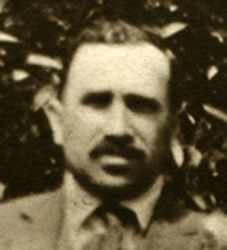
Jeno Saul Friedman
Birth:
circa 1878
Berehove, Zakarpats'ka oblast, Ukraine
Death:
November 1, 1927 (49)
Rahway, New Jersey, United States
Immediate Family:
Husband of Sarah Ethel Landau
Father of Tillie Florence Porter; Helen Friedman; Ruth Rosker and Milton Friedman, Nobel Memorial Prize in Economic Sciences, 1976
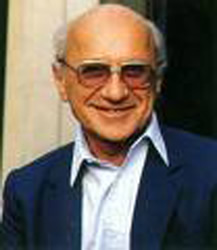
Milton Friedman, Nobel Memorial Prize in Economic Sciences, 1976 MP
Place of Burial:
Beth David Cemetery, Elmont, NY, USA
Birth:
July 31, 1912
Brooklyn, New York, United States
Death:
November 16, 2006 (94)
San Francisco, California, United States (Heart failure)
Immediate Family:
Son of Jeno Saul Friedman and Sarah Ethel Landau
Husband of Rose Friedman
Father of David Friedman and Janet Martel
Brother of Tillie Florence Porter; Helen Friedman and Ruth Rosker
Added by:
Gerald J. Porter on January 24, 2009
You
How are you related?
Path search in progress. If we find a path, we will notify you.
Sarah Ethel Landau
your relative?
Sarah Ethel Landau
Place of Burial:
Staten Island, New York, United States
Birth:
September 22, 1878
Berehove, Zakarpats'ka oblast, Ukraine
Death:
January 1952 (73)
Rahway, New Jersey, United States
Immediate Family:
Daughter of David Landau and Tobe Freida Landau
Wife of Jeno Saul Friedman
Mother of Tillie Florence Porter; Helen Friedman; Ruth Rosker and Milton Friedman, Nobel Memorial Prize in Economic Sciences, 1976
Sister of Anna (Honi) Landau; William Landau; Esther Grossman and Helen Austin
Half sister of Yolan Fisher; Eugene Landau and Esther Landau
Added by:
Gerald J. Porter on January 24, 2009
